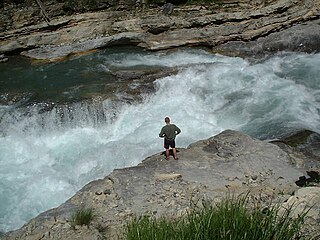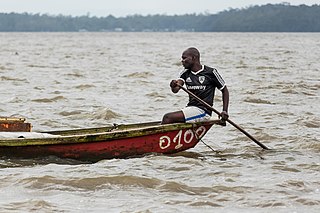
A boat is a watercraft of a large range of types and sizes, but generally smaller than a ship, which is distinguished by its larger size or capacity, its shape, or its ability to carry boats.

A kayak is a small, narrow human-powered watercraft typically propelled by means of a long, double-bladed paddle. The word kayak originates from the Inuktitut word qajaq. In British English, the kayak is also considered to be a kind of canoe.

A paddle is a handheld tool with an elongated handle and a flat, widened distal end, used as a lever to apply force onto the bladed end. It most commonly describes a completely handheld tool used to propel a human-powered watercraft by pushing water in a direction opposite to the direction of travel. It is different from an oar in that the latter is attached to the watercraft via a fulcrum.

Whitewater forms in the context of rapids, in particular, when a river's gradient changes enough to generate so much turbulence that air is trapped within the water. This forms an unstable current that froths, making the water appear opaque and white.

A watercraft or waterborne vessel is any vehicle designed for travel across or through water bodies, such as a boat, ship, hovercraft, submersible or submarine.

Whitewater kayaking is an adventure sport where a river is navigated in a decked kayak. Whitewater kayaking includes several styles. River running; where the paddler follows a river and paddles rapids as they travel. Creeking usually involving smaller, steeper, and more technical waterways. Creek boats tend to be short but high volume to allow for manoeuvrability while maintaining buoyancy. Slalom requires paddlers to navigate through "gates". Slalom was originally the only whitewater event to be in the Olympics but Kayak Cross - a new subcategory of slalom involving gates and more natural whitewater elements - featured in the 2024 Paris Olympics. Play boating involves staying on one feature of the river and is more artistic than the others. Squirt boating uses low-volume boats to perform special moves in whitewater features.

Boating is the leisurely activity of travelling by boat, or the recreational use of a boat whether powerboats, sailboats, or man-powered vessels, focused on the travel itself, as well as sports activities, such as fishing or waterskiing. It is a popular activity, and there are millions of boaters worldwide.

Tubing, also known as inner tubing, bumper tubing, towed tubing, biscuiting, or kite tubing, is a recreational activity where an individual rides on top of an inner tube, either on water, snow, or through the air. The tubes themselves are also known as "donuts" or "biscuits" due to their shape.
Paddle UK is a national governing body in the United Kingdom for canoeing, kayaking and other paddlesports such as standup paddleboarding. Established in 1936 as the British Canoe Union, it federalised in 2000 to become the umbrella organisation for the home nation associations in Scotland, Wales and Northern Ireland. In 2015 it took on the name British Canoeing and amalgamated the former British Canoe Union, Canoe England and GB Canoeing. In March 2024, British Canoeing changed their name to Paddle UK.

Canoe diving and Kayak diving are recreational diving where the divers paddle to a diving site in a canoe or kayak carrying all their gear in or on the boat to the place they want to dive. Canoe or kayak diving gives the diver independence from dive boat operators, while allowing dives at sites which are too far to comfortably swim, but are sufficiently sheltered.

Paddling, in regard to waterborne transport, is the act of propelling a human-powered watercraft using at least one hand-held paddle. The paddle, which consists of one or two blades joined to a shaft, is also used to steer the vessel via generating a difference in propulsion between the two sides of the watercraft. The paddle is not connected to the boat, unlike in rowing where the oar is attached to the boat.
The number of personal watercraft-related accidents has increased with the popularity of personal watercraft (PWC) since their introduction during the late 1960s. The use of the term jet ski for all types of PWCs is a misnomer; Jet Ski is a registered trademark in the United States for a line of PWCs manufactured by Kawasaki. With the increased use of personal watercraft since their inception, the hazards accompanying their use have also increased. According to U.S. government reports, most accidents are associated with rental operators, underage operators, under-trained and undereducated boaters and a variety of factors associated with recreational-boating accidents. Due to their affordability, ease of use, and relatively low transportation and maintenance costs, personal watercraft have significantly increased the number of water-based enthusiasts in the U.S. This rise in participation has created conflicts between the various boating segments in the U.S. and a need for additional boater education. Recreational-boating accidents are the second-largest transportation-related cause of injury in the U.S..

Canoeing – recreational boating activity or paddle sport in which you kneel or sit facing forward in an open or closed-decked canoe, and propel yourself with a single-bladed paddle, under your own power.

Human-powered watercraft are watercraft propelled only by human power, instead of being propelled by wind power or an engine.

A boat livery is a boathouse or dock on a lake or other body of water, where boats are let out for hire (rental), usually on an hourly, daily or weekly basis. Boats may be powered or sail craft or human powered like rowboats, paddleboats (pedalos) or inflatable boats. The primary use of the boats is recreational.
Confluence Outdoor is an American manufacturer of kayaks, canoes, and related accessories. The company comprises seven separate brands which each specialize in paddling sport boats or accessories.

Scuba diving tourism is the industry based on servicing the requirements of recreational divers at destinations other than where they live. It includes aspects of training, equipment sales, rental and service, guided experiences and environmental tourism.
















